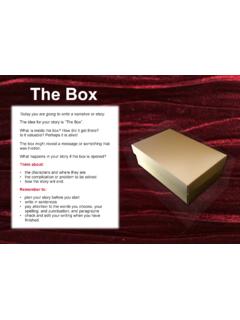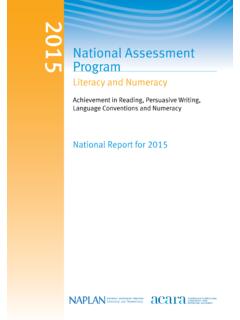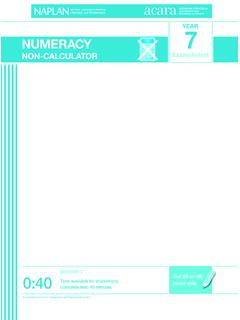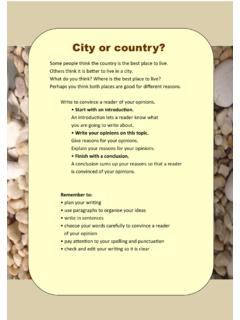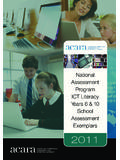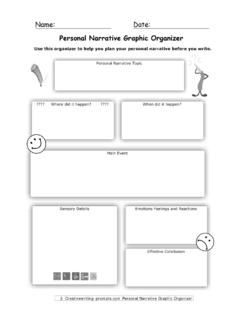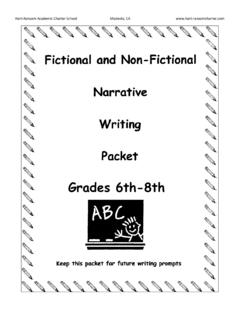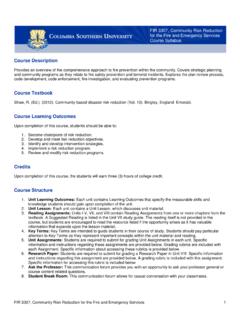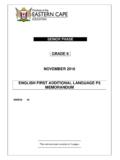Transcription of WritiNg - NAP
1 NatioNal assessmeNt Program literacy aNd Numeracy 2010 WritiNgNarrative markiNg guide2 CONTENTS Criteria 6 Annotated exemplars 16 Discussion scripts 72 Additional information 76 Glossary of grammatical items 78 Spelling reference list 833 AudienceText structureIdeasCharacter and structurePunctuationSpelling0 60 40 50 40 50 40 20 60 50 6 Assessing WritiNg in the National Assessment ProgramThe WritiNg taskThe WritiNg task for this test is a narrative . It is the same task for all students in Years 3, 5, 7 and 9. The administration of the WritiNg tasks employs closely scripted scaffolding. The teacher reads the directions on the WritiNg prompt aloud to all students. The prompt includes images which can support students in crafting their response. Students have 5 minutes to plan, 30 minutes to write and 5 minutes to edit.
2 DefinitionThe following definition of the social purposes of the narrative has shaped the development of the criteria. It has also shaped the delineation of the essential structural components required for the task. A narrative is a time-ordered text that is used to narrate events and to create, entertain and emotionally move an audience. Other social purposes of narrative WritiNg may be to inform, to persuade and to socialise. The main structural components of a narrative are the orientation, the complication and the resolution. CriteriaThe ten criteria assessed in the WritiNg task are: 1. Audience The writer s capacity to orient, engage and affect the reader2. Text structure The organisation of narrative features including orientation, complication and resolution into an appropriate and effective text structure3.
3 Ideas The creation, selection and crafting of ideas for a narrative4. Character and setting Character: The portrayal and development of character Setting: The development of a sense of place, time and atmosphere5. Vocabulary The range and precision of language choices6. Cohesion The control of multiple threads and relationships over the whole text, achieved through the use of referring words, substitutions, word associations and text connectives7. Paragraphing The segmenting of text into paragraphs that assists the reader to negotiate the narrative8. Sentence structure The production of grammatically correct, structurally sound and meaningful sentences9. Punctuation The use of correct and appropriate punctuation to aid reading of the text10.
4 Spelling The accuracy of spelling and the difficulty of the words used. The following table shows criteria and the range of score points for the WritiNg beginning the WritiNg test, all students are given a coloured WritiNg test stimulus sheet and are read the following instructions:Today you will do a WritiNg test. In this test you are going to write a narrative . Narratives are also called have to write a story about the topic. You can use the ideas from this stimulus sheet or you can use your own ideas about this. Look at the pictures and the words to help you with your marking in 2010, information will be collected on whether students have written on the assigned topic. This will be done by markers recording a 0 or 1 against the criterion.
5 Comprehensive training on how to assess whether a student has written on topic or not will be provided to all markers in all Australian marking centres prior to the commencement of this marking guideThe top of each page shows the criterion name and number. The skill focus defines the underlying skillbeing assessed. The category descriptor is a broad statement describing the particular skill level. This is an overall statement that should be used to make the information is included to help shape the judgement. However, this information should not be read as an exhaustive at the bottom of the page provide clarifying detail where scripts which exemplify the standard for a particular score are listed. (The number in brackets is the page reference.)
6 The script and annotations supporting the score are organised in the middle section of the marking glossary of terms used in the rubric is provided after the list of spelling words is included at the back of the guide. This list should be used in conjunction with the spelling criterion on page 15. The list is not descriptorAdditional informationSample scripts0 symbols or drawings which have the intention of conveying meaningRole-play writer (16)1 contains some simple written contentDungaun (17)2 shows awareness of basic audience expectations through the use of simple narrative markersSimple narrative markers may include: simple titles formulaic story opening: Long, long ago .. Once a boy was walking when .. description of people or placesThe casel (19)BMX (21)My Story (23)Living dead (25)3 an internally consistent story that attempts to support the reader by developing a shared understanding of context contains sufficient information for the reader to follow the story fairly easilyWoodern box (27)One sunny morning (29)October 16, 1981 (33)Zip (35)The shade whispered (75)4 supports reader understanding attempts to engage the readerNarrative devices may include: fantasy, humour, suspense sub-genre styles ( satire, boys own, chick lit) intertextual referencesLanguage choices may.
7 Control writer/reader relationship reveal values and attitudes establish narrator stance subvert expectations evoke an emotional response encourage reflection display ironySpace Tour (39)The haunted house (41)Gambat (45) 5 supports and engages the reader through deliberate choice of language and use of narrative devicesTracy (47)Best friends (51)Lovely purple boots (55)6 caters to the anticipated values and expectations of the reader influences or affects the reader through precise and sustained choice of language and use of narrative devicesThe Water Tower (59)In the distance (63)Axe (67)The Deep Blue Nothing (71)AudienceSkill focus: The writer s capacity to orient, engage and affect the descriptorAdditional informationSample scripts0 no evidence of any structural components of a time-sequenced text symbols or drawings inappropriate genre, eg a recipeRole-play writer (16)1 minimal evidence of narrative structure, eg a story beginning only or a middle with no orientation a recount of events with no complication note that not all recounts are factualDungaun (17)The casel (19)BMX (21)Zip (35)Space Tour (39)2 contains a beginning and a complication where a resolution is present it is weak, contrived or tacked on ( I woke up,I died, They lived happilyever after) A complication presents a problem to be solved, introduces tension, and requires a response.
8 It drives the story forward and leads to a series of events or responses. Complications should always be read in context. may also be a complete story where all parts of the story are weak or minimal (The story has a problem to be solved but it does not add to the tension or excitement.)My Story (23)Living dead (25)Woodern box (27)One sunny morning (29)The shade whispered (75)3 contains orientation, complication and resolution detailed longer text may resolve one complication and lead into a new complication or layer a new complication onto an existing one rather than concludeSophisticated structures or plot devices include: foreshadowing/flashback red herring/cliffhanger coda/twist evaluation/reflection circular/parallel plotsOctober 16, 1981 (33)The haunted house (41)Gambat (45)Tracy (47)Best friends (51)Lovely purple boots (55)4 coherent, controlled and complete narrative , employing effective plot devices in an appropriate structure, and including an effective endingThe Water Tower (59)In the distance (63)Axe (67)The Deep Blue Nothing (71)Text structure Skill focus.
9 The organisation of narrative features including orientation, complication and resolution into an appropriate and effective text descriptorAdditional informationSample scripts0 no evidence or insufficient evidence symbols or drawingsRole-play writer (16)1 ideas are very few and very simple ideas appear unrelated Dungaun (17)The casel (19)BMX (21)2 ideas are few, not elaborated or very predictableMy Story (23)Living dead (25)3 ideas show some development or elaboration all ideas relate coherently to a central storyline some ideas may contain unnecessary elaboration (waffle)Woodern box (27)One sunny morning(29)October 16, 1981 (33)Zip (35)Space Tour (39)The haunted house (41)Tracy (47)The shade whispered (75)4 ideas are substantial and elaborated ideas effectively contribute to a central storyline the story contains a suggestion of an underlying themeGambat (45)Best friends (51)5 ideas are generated, selected and crafted to explore a recognisable theme ideas are skilfully used in the service of the storylineIdeas may include: psychological subjects unexpected topics mature viewpoints elements of popular culture satirical perspectives extended metaphor traditional sub-genre subjects: heroic quest whodunnit good vs evil overcoming the oddsLovely purple boots (55)The Water Tower (59)In the distance (63)Axe (67)The Deep Blue Nothing (71)IdeasSkill focus.
10 The creation, selection and crafting of ideas for a and setting are essential components of effective narrative WritiNg . The inclusion of the AND/OR category is necessary as different types of stories may focus on only one stories may be character-driven ( Pippi Longstocking by Astrid Lindgren) and the setting may be very sketchy or undeveloped. Other stories, which attempt to build atmosphere and suspense, may focus on setting the scene ( the wild west genre) with little character detail. Many stories will have a balance of these two components. Category descriptorAdditional informationSample scripts0 no evidence or insufficient evidence symbols or drawingsRole-play writer (16)1 only names characters or gives their roles ( father, the teacher, my friend, dinosaur, we, Jim)AND/OR only names the setting.

